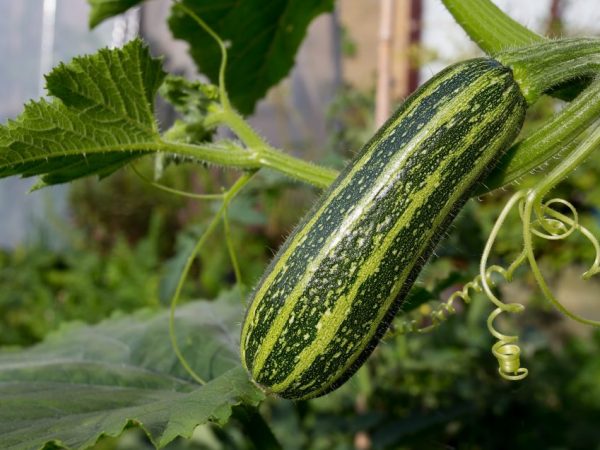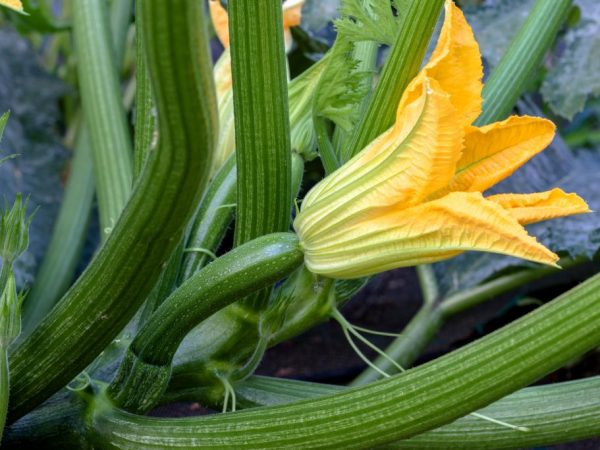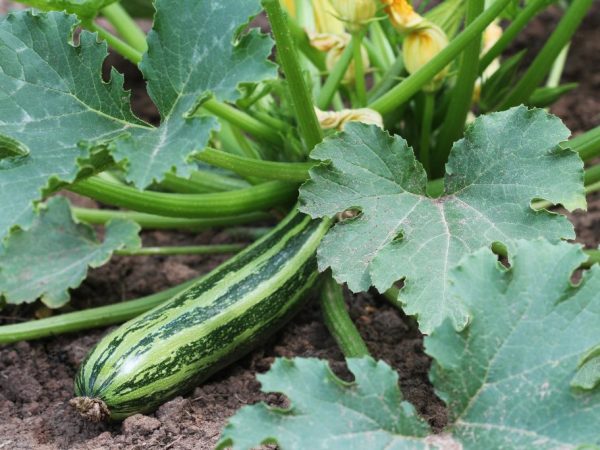Zebra zucchini
The zucchini Zebra, bred in 1987, is of great interest to gardeners. It belongs to the category of zucchini and has a pleasant taste. This variety is capable of giving a large harvest if you follow certain rules for caring for it.

Zebra zucchini
Description of the variety
Zebra zucchini got this name because of the shade of the fruit. Zucchini are decorated with longitudinal stripes of light and dark green colors and small splashes. They have the shape of an irregular elongated cylinder with a thickening towards the nose. The surface is smooth to the touch, covered with small projections.
Description of the inside of the fruit:
- accommodates three placental chambers of an open type and dense structure;
- zucchini pulp Zebra is whitish-yellow, tender, juicy, tastes like pineapple because of the sweetness;
- the vegetable is rich in natural sugars, vitamins of groups A, C, PP, folic acid, water.
The green part of the plant is in the form of a medium-sized bush with short lashes. The leaves are large, with deep cuts, dark green in color. Suitable for growing in conditions of central Russia, Siberia and southern regions.
Yield
Zebra zucchini belongs to the early maturing varieties. Full ripening of the first fruits occurs 35-40 days after planting. The vegetable is widely used for industrial cultivation due to its high yield. During the season, it will be possible to collect 11-15 kg of fruits from one bush.
With greenhouse cultivation, productivity indicators are slightly lower - up to 10 kg per 1 m². In all conditions, the zucchini reaches a good size:
- average length - 15-20 cm;
- fruits can grow up to 35 cm;
- the weight of the vegetable, ready for use, is 500-600 g;
- maximum weight - 1-1.2 kg.
Fruit application
The zucchini variety is suitable for creating dishes; it is used for the same purposes in mass production. The most popular are the following dishes made using this variety:
- squash caviar;
- adjika and oriental sauces;
- canned assorted vegetables;
- kebabs and grills;
- stuffed and baked zucchini;
- fresh young fruit salads;
- pancakes, toasted vegetables, stew.
Old zucchini are often used for silage, combined with other crops. Fresh vegetables and lashes are fed to rabbits, small and large livestock, poultry, pigs. Zebra zucchini seeds are also of great interest as a component of the pet diet.
Disease and pest resistance

The variety is resistant to many diseases
The zucchini variety is resistant to many ailments, but some diseases manifest themselves under certain conditions. These include powdery and downy mildew, gray rot, anthracnose. Symptoms:
- round light spots on the surface of the leaves;
- unpleasant bloom of white or gray;
- dark dots of different sizes on cuttings, green mass, buds and ovaries;
- lesions that look like burns that increase in size.
Changes in the shade of the leaves are often caused by an illness. Drying can occur for natural reasons, when the plant needs to shed old covers.The same happens due to drought, lack of minerals.
The pests that often infect zucchini zebra include spider mites and aphids. They feed on the sap of the plant, thereby gradually killing it. To combat insects, folk remedies and fungicides are used.
Advantages and disadvantages of the variety
Zebra variety is unpretentious in care, easily adapts to different conditions. It is grown outdoors, in a greenhouse and even in a house in winter. Advantages of zucchini zucchini:
- easy tolerance to high temperatures and frost resistance;
- obtaining a high yield in a short period;
- pleasant taste that is preserved during heat treatment;
- beautiful and neat fruits and bushes;
- the ability to keep fresh vegetables for up to 2 months;
- possibility of transportation over long distances without damaging the skin.
The disadvantages of the plant include selectivity in soils, intolerance to excessive moisture. Water saturation often causes infectious and putrefactive processes in zucchini. If the infected leaves are not removed in time, the disease will spread to the entire bush and kill it.
To get a large harvest, you need to take into account the region of residence. Zebra zucchini begin to actively bear fruit when the air temperature does not drop below 11 ° C. Proper care, taking into account all the nuances, will also lead to a good result.
Landing
This variety is planted in several ways, the choice depends on the geographic location and preferences of the owner. In the northern regions, garden work lasts from mid or late May, while further diving under the film is expected. In central Russia, planting is done in early May. In the south, they prefer to devote time to such work at the end of April.
The choice of a place for placing a culture is made taking into account its preferences. A sunny area that is not blown through by drafts is suitable for planting. There are two main ways to breed zucchini:
- To get seedlings at home, the seeds are left to germinate in wet gauze for several days. When they hatch, they prepare a mixture of black soil with sand, place each grain to a depth of 1.5-2 cm.At the same time, moderate humidity and a comfortable air temperature of 18-23 ° C are maintained, the chosen place should be illuminated 11 hours a day. When the 4th leaf appears, the plants are planted in the soil.
- Preparation for sowing in the ground or picking seedlings begins in the fall. They choose a place where nightshades, annual grasses, beets, potatoes or cabbage previously grew, the bottom layer is insulated with fallen leaves. In the spring, pits are dug up to 7 cm deep, the bottom is covered with compost. Plants are placed so that 1-2 vegetables per 70 × 70 cm square. The planted seeds are watered.
Care

The plant needs mandatory feeding
Zebra zucchini prefer soils rich in useful elements. Therefore, they need to be fed regularly. Fertilizer is applied under the root three times: when planting in the ground, before flowering and before fruiting. They do well with the task of humus, compost, ash. Surface spraying of the bush is performed to strengthen the green mass, improve the quality and quantity of ovaries.
Liquid fertilizers include the following:
- potash solutions;
- superphosphate;
- saltpeter;
- mullein and chicken droppings.
Zucchini is required to be sprayed for prophylaxis. For this, 1 tsp. copper sulfate is mixed with boric acid, 5 g of manganese sulfate, 10 g of urea in 10 liters of water are added. Top dressing is applied next to the root several times per season.
Watering is an important aspect of grooming. It is carried out 1-2 times a week, when the ground is dry enough. Excessive moisture saturation should not be allowed. Watering is stopped 7-10 days before harvesting. it improves the flavor of the zucchini zebra.
No pruning of bushes is required for the variety. If yellowed or soil-contaminated leaves are seen, they are removed to prevent disease.Collecting fruits every 2-3 days will ensure even development of the ovaries. To improve aeration and speed up the ripening process, a couple of middle sheets are removed.
Conclusion
Zucchini Zebra yields a large harvest already in the early stages. Zucchini planted in open ground, after each watering, need weeding and hilling, otherwise weeds will quickly grow. The zucchini variety has a pleasant taste, therefore it is loved by many gardeners.

